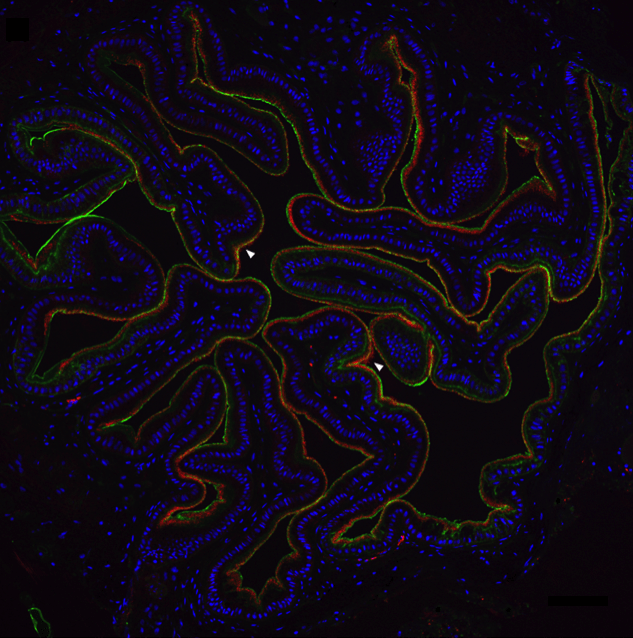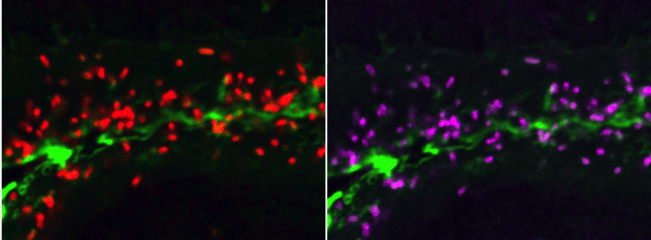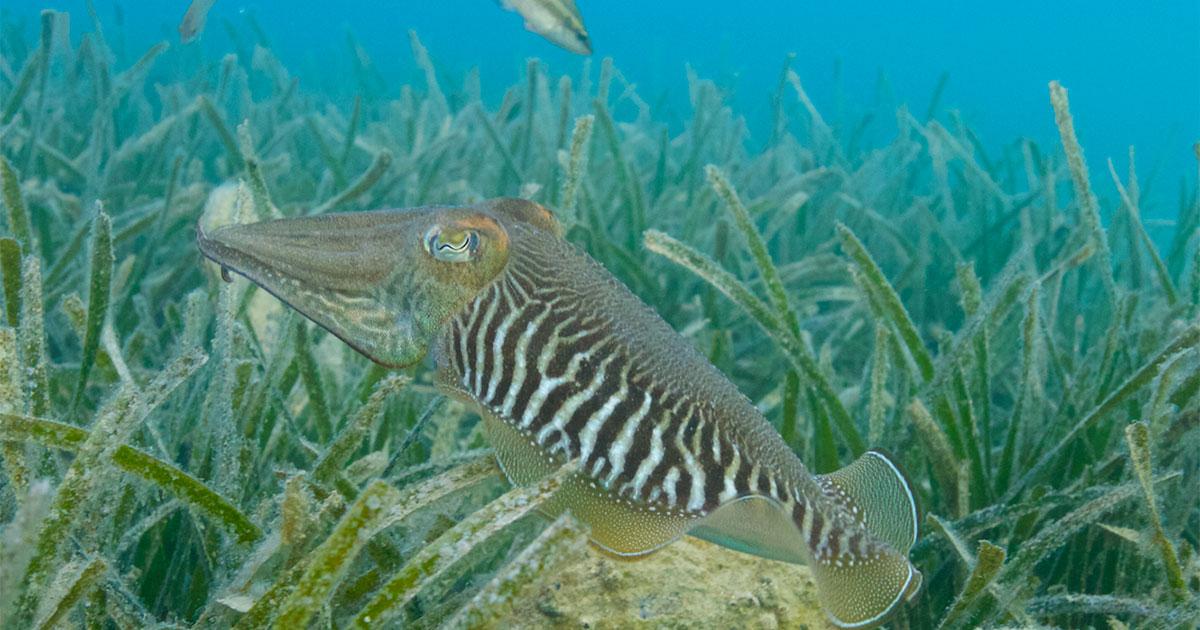Animals have an intimate and important connection with the microbial populations (microbiomes) that live inside their bodies. This holds for the behaviorally sophisticated cuttlefish, whose microbiome, it turns out, contains only two different kinds of bacteria.
In a collaboration led by Marine Biological Laboratory (MBL) scientist Jessica Mark Welch, scientists characterized the microbiome of the European common cuttlefish, Sepia officinalis, an animal whose impressive camouflage skills and behavior have long been studied. They published their findings in this month's issue of mSystems.
 A layer of bacteria in an unusual place, the esophagus of a cuttlefish. Bacteria (red) are in a layer of mucus (green) lining the inside of the esophagus. Cuttlefish cell nuclei are shown in blue. Credit: Tabita Ramírez-Puebla and Jessica Mark Welch
A layer of bacteria in an unusual place, the esophagus of a cuttlefish. Bacteria (red) are in a layer of mucus (green) lining the inside of the esophagus. Cuttlefish cell nuclei are shown in blue. Credit: Tabita Ramírez-Puebla and Jessica Mark Welch
The project began when Roger Hanlon of the MBL and Jack Gilbert of University of California, San Diego, chose the cuttlefish to look for a connection between the gut microbiome and behavior. However, they first needed to identify the microbes present.
"Not much is known about the microbiomes of cephalopods (cuttlefish, squid and octopus), other than a famous symbiosis between the bobtail squid and Vibrio bacteria in its light organ," says Mark Welch.
Holly Lutz, a postdoctoral scientist from Gilbert's lab, examined microbial populations from the cuttlefish's digestive tract, gills, and skin. She found that the cuttlefish microbiome has just two families of bacteria: Vibrionaceae and Piscirickettsiaceae. By comparison, humans have hundreds of different kinds of bacteria in the gut microbiome alone.
The simplicity of the cuttlefish microbiome came with other surprises. Tabita Ramírez-Puebla, a postdoctoral scientist at the MBL, fluorescently probed the bacteria to reveal their organization under the microscope. "It turned out that most of the microbes were in the esophagus, an unusual place to find the most dense community of microbes," says Mark Welch.
Bacteria in the Vibrio family include some species that cause disease, but others form symbiotic relationships with their hosts, such as in the bobtail squid. "It's interesting that we find those Vibrios in association with the cuttlefish. It suggests that there is a long-term evolutionary relationship between Vibrios and marine invertebrates," says Mark Welch.
While Vibrio species are sometimes found in the gastrointestinal tract of fish, the findings hint at an expanded range of organisms and body sites associated with Vibrio. It's possible that Vibrio species in the esophagus serve as a reservoir of bacteria that seed the cuttlefish gut, bringing along enzymes that can aid in digestion. Or Vibrio colonization of the esophagus (and the rest of the animal) may be pathogenic or opportunistic.
 Identifying bacteria in the esophagus of the cuttlefish. In this close-up view, two different probes both identify the same cells: red shows bacteria and purple shows the family Vibrionaceae. Using more than one probe increases confidence in the identification. Credit: Tabita Ramírez-Puebla and Jessica Mark Welch
Identifying bacteria in the esophagus of the cuttlefish. In this close-up view, two different probes both identify the same cells: red shows bacteria and purple shows the family Vibrionaceae. Using more than one probe increases confidence in the identification. Credit: Tabita Ramírez-Puebla and Jessica Mark Welch
Understanding the microbiome of cuttlefish can help aquariums care for these animals. "We need to know how to keep them healthy and knowing something about their microbiome is very useful," says Mark Welch. For example, antibiotic treatment can alter an animal's microbiome, causing unintended consequences elsewhere in the animal. In their study, the scientists treated cuttlefish with enrofloxacin, an antibiotic commonly used by aquarium veterinarians. They found enrofloxacin had no effect on the cuttlefish microbiome.
Story by Jennifer Tsang, Marine Biological Laboratory, University of Chicago
Journal Reference:
Holly L. Lutz, S. Tabita Ramírez-Puebla, Lisa Abbo, Amber Durand, Cathleen Schlundt, Neil R. Gottel, Alexandra K. Sjaarda, Roger T. Hanlon, Jack A. Gilbert, Jessica L. Mark Welch. A Simple Microbiome in the European Common Cuttlefish, Sepia officinalis. mSystems, 2019; 4 (4) DOI: 10.1128/mSystems.00177-19
This research is part of the Microbiomes and Genomes of Marine Organisms initiative at the MBL, which aims to develop more than 100 species of diverse marine organisms as systems to investigate host-microbe interactions. Understanding an organism’s microbiome can open many doors for exploration of behavior, ecology, evolution, and more. In the case of the cuttlefish, whose behavior is well studied, they provide a unique opportunity to study how changes in its microbiome may affect behavior.



